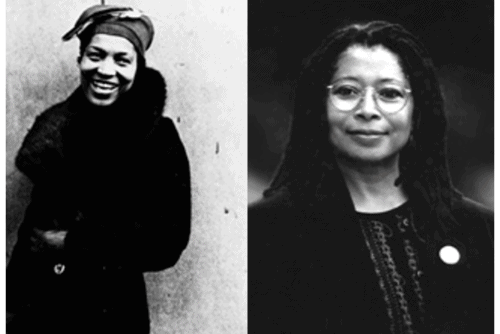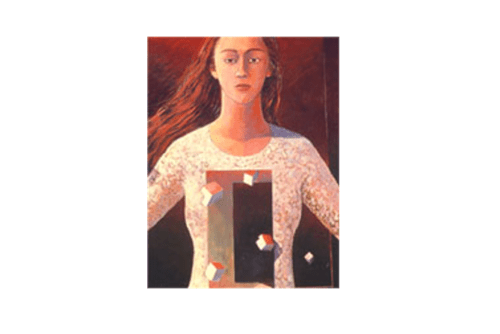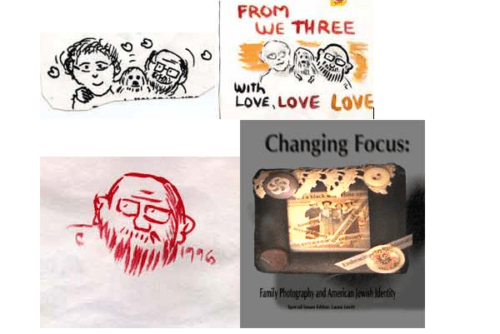Voicing Voicelessness
Essentially, Hurston is saying that her becoming a writer is tantamount to a rock learning to talk. In fact, the rocks will talk through her. And who are these “dead-seeming, cold rocks” but the tens of thousands of rural black women, considered less than beasts and denied a voice in history and letters.
-Susan Wlllis (1987)1
Silence is often something evoked rather than contained. Emma’s silence is a nonverbal expression of the complexity of her social circumstances arising from lack of, or disengagement with, language itself. Silence is frequently misunderstood; a character’s lack of speech is simply ignored, with the assumption that there is “nothing” but silence. But onstage, where the body remains even if words do not, presence is a critical component in the formation of meaning. Once we recognize Emma’s silent presence onstage as significatory, we can understand her condition.
In the final scene, John returns. Emma lives, as the stage directions explain, “in a one-room shack in an alley.” Hurston describes the interior as containing a “cheap” rocker and bed. As the curtain rises, a woman-Emma, though we are not told it is her and the stage is in virtual darkness – “is seen rocking to and fro in the low rocker.” Hurston may have described her as “a woman” in order to endow her with universal meaning. There is “dead silence except for the sound of the rocker and an occasional groan from the bed.”2 Then, the woman rises in response to a “faint voice” that says “water”; she gives water to the child. She is on her way to the doctor again when John enters. It is John’s entrance that distracts her; he interferes with her care of the child. He reports that he lived “up North” in Philadelphia, but his wife died and he now has returned to Emma permanently. John persists in trying to light the oil lamp, but Emma won’t have it, preferring to sit by herself in the dark. He tries to soften her by recalling their youthful romance. He finally lights the lamp, only to see the ill child for the first time. He bends over for a closer look. Emma tries to shield the child from him. The stage directions are as follows:
He turns in his chair and Emma rushes over to the bed and covers the girl securely, tucking her long hair under the covers, too-before he arises. He goes over to the bed and looks down into her face. She is mulatto. Turns to Emma teasingly.
John: Talkin’ bout me liking high-yallers—yo husband musta been pretty near White.3
John realizes that the child is feverish. Emma assures him that she has tried to find the best doctors within her limited means. John urges Emma to seek the doctor. A worried but defeated Emma says “She’ll be all right, Ah reckon, for a while.” Then she says: “John, you love me-you really want me sho’ nuff?”4 Before going for the doctor again, she tries to find out exactly why John has returned.
Critics have assumed that Emma’s selt-hatred is at the root of her neglect of the child. However, she never actually neglects the child, but rather pauses briefly in order to probe John’s sincerity. In the next exchange, John declares his love, and Emma even suggests that they marry the following day. John agrees, urging her once more: “run after the doctor – we must look after our girl.” As Emma readies herself, John says, looking at the child: “Gee, she’s got a full suit of hair! Glad you didn’t let her chop it off.”4 Hurston makes it clear: for John nothing has changed. He is enamored by the child’s long, straight hair, symbolic of whiteness, femininity, beauty, and everything that in his eyes Emma is not.5 But Emma, instead of going for the doctor, returns to her rocker. John sits next to her. He enjoins her yet again to find a doctor, offering money for the taxi. At last, Emma agrees.
The doctor arrives shortly after Emma returns, suggesting that Emma summoned him. Before he arrives, she enters the room, finding John helping the child. She rushes furiously toward him, threatening to “kill him.” John struggles to free himself of Emma’s grip and exclaims before leaving: “So this is the woman I’ve been wearing my heart like a rose for twenty years! She so despises her own skin that she can’t believe any one else could love it!”6 Emma’s self-hatred drives a wedge between them and her delay costs the child her life. On the face of John and the child appear to be the ones wronged. Emma, it might seem, has unjustly accused John of unfaithlulness. Yet, during John’s twenty years of’ “waiting” he was married, probably to the light-skinned Effie. Despite his protestations, he hardly wore his “heart like a rose.” Instead, he only returned after twenty years and the death of his wife. More important, his attention to the child may have suggested to Emma John’s lust for “mulattoes,” and most like she would not be entirely wrong in this.
During the play’s final moments, the doctor arrives. He asks Emma why she had not summoned him sooner. She replies that she had. He remarks that she waited too long, and that this procrastination will prove fatal. “An hour more or less is mighty important sometimes,” he says, adding: “Why didn’t you come”? Emma replies: “Couldn’t see.”7 The doctor offers pills sympathetically and leaves quietly.
Emma’s final words in the play are, “couldn’t see.” What is it that she failed to see? There are several possible answers, none of them adequate. Hurston, like Chekhov, resists easy explanations. With guarded certainty it might be said that she delayed in responding to the child’s turn for the worse because she had to “see” John’s sincerity. Or, perhaps it is also the fact that she “couldn’t see” her own hatred for the child because it reminded her of John’s desires, about whom and which she may have thought angrily about while conceiving it, given John’s skin tone preferences. Or, it may in fact be Hurston’s use of melancholia raised to a symbolic level.
The play closes in silence.8 Emma is rocking in her chair next to the now dead child. The audience sits with her in silence. The experience of sitting and observing her rocking is more theatrically basic than dialogue. There is nothing verifiable with certainty, and this is how it should be. Explanations reduce meaning to mere descriptions, and these descriptions often fail to delineate the unspeakable reality. Emma’s story cannot be explained; it is essentially unfinished and without resolution.
The play’s disjointed structure reflects the protagonist. It presents Emma in fragments because there is no whole “Emma.” Crispin Sartwell realizes that in many of Hurston’s literary figures, there is contained a “miscellaneous self, or nonself,” which is “precisely the self that could not be spoken.” Sartwell sees this as an extension of Hurston’s autobiographical input into her fictional characters; Hurston’s own sense of self is neither a “racial self,” nor is it “culturally constructed” At the deepest level, he explains, the self Hurston creates “exceeds or is incomprehensible to any construction,” because “it is bits and pieces; the self Hurston asserts is in a sense not anything in particular.”9 Emma is also bits and pieces and nothing in particular.
In 1928, just three years following completion of Color Struck., Hurston wrote “How It Feels to Be Colored Me”:
I feel like a brown bag of miscellany propped against a wall. Against a wall in company with other bags, white, red, and yellow. Pour out the contents, and there is discovered a jumble of small things priceless and worthless. . . . In your hand is the brown bag. On the ground before you is the jumble it held. … A bit of colored glass more or less would not matter.10
This may serve to explain Color Struck. Hurston may have inserted her own feelings into the creation of Emma. The stage picture ends in the following way:
She seats herself and rocks monotonously and stares out of the door. A dry sob now and then. The wind from the open door blows out the lamp and she is seen by the little light from the window rocking in an even, monotonous gait, and sobbing.11
The image of Emma in fragments can be explained as an expression of Hurston’s own experience. The final moment onstage reveals Hurston’s talent for documenting the social conditions of black women in the South, but it also shows her talent for seamlessly inserting her thoughts and feelings into the fabric of her fictional characters. Emma’s isolation may be both a symbolic representation of black southern women and a personal experience drawn from the author’s imagination.
The door onstage represents the outside world, with its opportunities of emigration. “Outside” belongs to the community, realized in cakewalking, mobility, socialization, and the “renaissance” up North. Inside, Emma sits monotonously alone, presenting the audience with the spectacle of her uneventful life. Left alone, she rocks. There is, as Toni Morrison informs us, a “loneliness that can be rocked.” This rocking, says Morrison, is expressed in silence and the body: “Arms crossed, knees drawn up; holding, holding on, this motion, unlike a ship’s, smooths and contains the rocker. It’s an inside kind – wrapped tight like skin.”12 At the end of the play Emma is left with a life like “a bit of colored glass,” which, as Hurston notes, “more or less would not matter.” She rocks and waits, like a Beckett character, for nothing. In the process, the “black woman” is granted tragic dignity.
Hurston limns Emma as a representation of black women who have slipped through the cracks of history. Hurston’s anthropological act of recovery follows Boas’s precepts of “fieldwork” and “objective study,” while simultaneously fashioning the research into dramatic form. As a fictional yet carefully documented representation of black women at the time, Emma deserves recognition as a significant figure within the New Negro-Harlem Renaissance literature. Although the protagonist stands outside the traditional depictions of Harlem Renaissance fiction and documentation (which may be why the play has been largely ignored), she nonetheless reflects the social conditions of a great many caught in similar circumstances. It is the fact that Emma stands as a creative representation of so many people now forgotten, and because the protagonist is portrayed as a profound characterization of voicelessness and fragmentation, that Hurston’s play represents an important document of its era.
- Susan Willis, Specifying: Black Women Writing the American Experience (Madison: University of Wisconsin Press, 1987), 36. [↩]
- Hurston, Color Struck, 12. [↩]
- Ibid., 13. [↩]
- Ibid. [↩] [↩]
- For a study of African American women’s relationship to beauty, hair, and especially the history of Madam C. J. Walker, the entrepreneurial business leader who developed an empire of beauty products (ca. 1905 to 1919), see Noliwe M. Rooks, Hair Raising, Beauty, Culture, and African American Women (New Brunswick: Rutgers University Press, 1996). [↩]
- Hurston, Color Struck, 14. [↩]
- Ibid [↩]
- For discussions on silence, see Peter Hitchcock, Dialogics of the Oppressed (Minneapolis: University of Minnesota Press, 1993), and Bernard P. Dauenhauer, Silence: The Phenomenon and Its Ontological Significance (Bloomington: Indiana University Press, 1980). [↩]
- Sartwell, Act Like You Know, 156, 158. [↩]
- Hurston, “How It Feels to Be Colored Me,” quoted in I Love Myself When I Am Laughing: A Zora Neale Hurston Reader, 155. [↩]
- Hurston, Color Struck, 14 [↩]
- Toni Morrison, Beloved (New York: Signet, 1991), 336. [↩]




